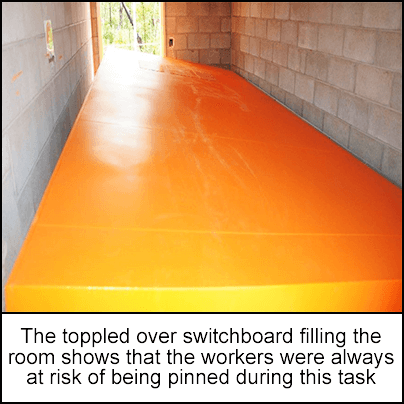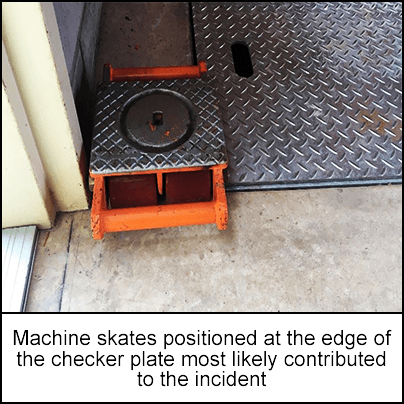-
What happened?
A switchboard was being manually moved into a room that had been purpose built to house it.
- The room was only 5 metres (16.5 feet) long and 2.4 metres (8 feet) wide.
- The switchboard was 4.5 metres (15 feet) long, 2.1 metres (7 feet) high and weighed 1.8 tonnes. A 7.5 centimetres (0.25 feet) steel frame was also fitted to the base of the switchboard.
Three workers were moving the switchboard using four load skates.
The load was being pushed over a cable pit covered by checker plates when it toppled backwards.
It pinned one of the workers between the wall and the switchboard, causing him serious head injuries.

-
Why did it happen?
It is likely a combination of factors lead to this incident:
- A skate knocked into the edge of a checker plate or the door frame.
- There was no ‘non-slip’ surface between the switchboard and skates, so when it was knocked, it dislodged the switchboard.
- Most of the electrical components were installed at the top of the switchboard, making it top heavy.
- The switchboard had a high centre of gravity and was prone to toppling.
- The injured worker was standing between the switchboard and a wall when it fell.
The room was too small to allow the switchboard to be moved in using machinery.
The equipment used was not fit for purpose:
- The load skates were designed to transport sheet metal, not the switchboard.
- The cable pit ran the full length of the room, so the load skates had to run along it to transport the switchboard.
- The checker plate over the cable pit was not flush to the ground.
No procedures were in place for using the skates.
No site risk assessment was conducted.
Workers did not have a clear understanding of the hazards associated with using load skates.

-
What did they learn?
Do not position yourself in the line of fire (e.g. between the load and a wall/other fixed structures) to avoid the risk of becoming pinned and seriously injured.
Load skates should only be used on solid flat smooth surfaces, free from any obstructions.
Match the correct skate design to the task being undertaken. Always opt for skates with at least 25% more capacity than your load.
The load should rest completely on the skate, and the skate plate should be fitted with a non-slip surface to prevent load shift or the skates dislodging.
Moving top heavy loads or loads with a high centre of gravity should be considered a high-risk activity.
Ensure there are documented safe work procedures for the use of load skates and all workers are aware of the potential hazards associated with using this equipment.
Ensure regular maintenance is carried out on the load skates.
Carry out risk assessments at every site to confirm suitability of equipment.
If two or more workers are manually moving a load, refer to relevant guidance on hazardous manual tasks.
Use general good practice:
- for working with load skates (correct design, weight capacity, how to load and unload).
- for working with heavy equipment (avoid standing in positions of danger)
Consider the dimensions of any large equipment that needs to be housed during the design phase.

-
Ask yourself or your crew
How can this happen here?
What is our procedure for using load skates?
What are the hazards when using load skates?
What should you do if you are asked to work in an unsafe manner?
What checks do you carry out before starting work to confirm that your equipment is suitable for the task and safety measures are in place?

Add to homescreen
Content name
Select existing category:
Content name
New collection
Edit collection
What happened?
A switchboard was being manually moved into a room that had been purpose built to house it.
- The room was only 5 metres (16.5 feet) long and 2.4 metres (8 feet) wide.
- The switchboard was 4.5 metres (15 feet) long, 2.1 metres (7 feet) high and weighed 1.8 tonnes. A 7.5 centimetres (0.25 feet) steel frame was also fitted to the base of the switchboard.
Three workers were moving the switchboard using four load skates.
The load was being pushed over a cable pit covered by checker plates when it toppled backwards.
It pinned one of the workers between the wall and the switchboard, causing him serious head injuries.

Why did it happen?
It is likely a combination of factors lead to this incident:
- A skate knocked into the edge of a checker plate or the door frame.
- There was no ‘non-slip’ surface between the switchboard and skates, so when it was knocked, it dislodged the switchboard.
- Most of the electrical components were installed at the top of the switchboard, making it top heavy.
- The switchboard had a high centre of gravity and was prone to toppling.
- The injured worker was standing between the switchboard and a wall when it fell.
The room was too small to allow the switchboard to be moved in using machinery.
The equipment used was not fit for purpose:
- The load skates were designed to transport sheet metal, not the switchboard.
- The cable pit ran the full length of the room, so the load skates had to run along it to transport the switchboard.
- The checker plate over the cable pit was not flush to the ground.
No procedures were in place for using the skates.
No site risk assessment was conducted.
Workers did not have a clear understanding of the hazards associated with using load skates.

What did they learn?
Do not position yourself in the line of fire (e.g. between the load and a wall/other fixed structures) to avoid the risk of becoming pinned and seriously injured.
Load skates should only be used on solid flat smooth surfaces, free from any obstructions.
Match the correct skate design to the task being undertaken. Always opt for skates with at least 25% more capacity than your load.
The load should rest completely on the skate, and the skate plate should be fitted with a non-slip surface to prevent load shift or the skates dislodging.
Moving top heavy loads or loads with a high centre of gravity should be considered a high-risk activity.
Ensure there are documented safe work procedures for the use of load skates and all workers are aware of the potential hazards associated with using this equipment.
Ensure regular maintenance is carried out on the load skates.
Carry out risk assessments at every site to confirm suitability of equipment.
If two or more workers are manually moving a load, refer to relevant guidance on hazardous manual tasks.
Use general good practice:
- for working with load skates (correct design, weight capacity, how to load and unload).
- for working with heavy equipment (avoid standing in positions of danger)
Consider the dimensions of any large equipment that needs to be housed during the design phase.
Ask yourself or your crew
How can this happen here?
What is our procedure for using load skates?
What are the hazards when using load skates?
What should you do if you are asked to work in an unsafe manner?
What checks do you carry out before starting work to confirm that your equipment is suitable for the task and safety measures are in place?
A worker received serious head injuries while helping to move a large electrical switchboard. The load toppled over, pinning the worker between a wall and the switchboard.














